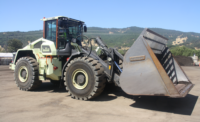
A unique industry collaboration has produced a new robot that could increase the speed and accuracy of layouts with the help of virtual design and construction technology.
Called Project Lion, the technology is the brainchild of Redwood City, Calif.-based DPR Construction and Westminster, Colo.-based Trimble. The firms are partnering on an autonomous layout robot, or "laybot," that applies robotic-total-station (RTS) technology to help it mark lines on slabs before interior construction. (You can see a YouTube video of the robot here.)
The layouts are accurate to within an eighth of an inch, says Dan Casale, a DPR project engineer and one of the project's creators. The straight-line speed of the laybot is between 1.8 and 2.2 linear ft per second. Turns take about 30 seconds each, Casale says.
The 75-lb laybot, which is 1.5 ft tall, 2 ft wide and 2 ft long, is guided by building information modeling files (using standard DXF or DWG file formats) that are loaded on its onboard computer. A prism mounted on its top receives signals from the RTS to guide it as it moves.
A series of marking pens then create the layout lines. The project team may soon test the use of standard inkjet cartridges. The team fitted the laybot with a set of omni wheels, allowing it to move forward, backward and diagonally as it receives instructions from the RTS. It is powered by ion batteries that can be recharged every three to four hours.
"We think this is a new, exciting technology that could change how we do things on jobsites," says Casale, who also demonstrated the laybot at ENR's FutureTech event last month.
Casale says the pilot grew out of DPR's work on the University of California, San Francisco, Mission Bay medical center, a one-million-sq-ft hospital with 180 beds. "We were self-performing the drywall on the project, so we had a great opportunity to see how we could leverage BIM to make ourselves more efficient," Casale notes.
The laybot can mark about 300 to 400 linear ft per hour, but the goal is 1,000 linear ft per hour, says Jim McCartney, a segment manager at Trimble. By comparison, experienced drywallers average 150 linear ft per hour, and the task usually requires two people using chalk lines and tape measures.
The laybot has the potential to reduce high-end labor hours for layout crews. "It's possible we could make them at least twice as efficient as they are now," McCartney says. Other advantages to the laybot is that it can work at night or right after a new floor is poured; it is safer, and it has better mobility, he says.
The laybot needs a clear line of sight to the RTS system in order to operate smoothly, so operators must be well trained in how to minimize obstacles, such as columns. "That may be tricky on busy jobsites," McCartney says. The laybot has a built-in safety feature that detects unexpected obstacles and, if the laybot bumps into something, shuts down the machine.
Atul Khanzode, DPR's director of virtual design and construction, says the technology has huge potential benefits to the industry. "It moves us more toward lean and doing more tasks virtually," he says. The laybot might eventually be used for data collection or measuring footings and planning excavation work. "It's really a Swiss Army knife of possibilities," McCartney adds. The team hopes to field-test it later this year and is mum on cost estimates of the robot at this point.
Jim Washburn of DPR says the firm started its innovation group specifically to find and develop initiatives such as this. "[Casales] brought us a great idea in Project Lion, and it has the potential to significantly increase efficiency within our company, our industry and beyond."



Post a comment to this article
Report Abusive Comment